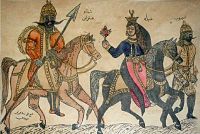Antarah ibn Shaddad
Antarah ibn Shaddad عنترة بن شداد | |
|---|---|
| عنترة بن شداد العبسي | |
Ancient Arabia, Arab world | |
Main interests | Arabic poetry |
Antarah ibn Shaddad al-Absi (Arabic: عنترة بن شداد العبسي), ʿAntarah ibn Shaddād al-ʿAbsī; AD 525–608), also known as ʿAntar, was a pre-Islamic African-Arab knight and poet, famous for both his poetry and his adventurous life. His chief poem forms part of the Mu'allaqāt, the collection of seven "hanging odes" legendarily said to have been suspended in the Kaaba at Mecca. The account of his life forms the basis of a long and extravagant romance.
Life

ʿAntarah was born in
He gained attention and respect for himself by his personal qualities and courage in battle, excelling as an accomplished poet and a mighty warrior. He earned his freedom after another tribe invaded the lands of the Banu ʿAbs. When his father said to him, "ʿAntarah, fight with the warriors", he replied that "the slave doesn't know how to invade or how to defend, but is only good for milking goats and serving his masters". His father answered him: "Defend your tribe, O ʿAntar, and you are free". After defeating the invaders, he sought to gain permission to
The time and manner of his death are a matter of dispute. Ibn Duraid has him slain by Wasr ibn Jabir[1] or in battle against the Tayy,[2] while according to Abu Obeida he died a natural death in old age.[1]
ʿAntarah's poetry is well preserved and often talks of chivalrous values, courage, and heroism in battle as well as his love for ʿAbla. It was immortalized when one of his poems was included in the Mu'allaqat, the collection of poems legendarily said to have been suspended in the Kaaba.[1] His poetry's historical and cultural importance stems from its detailed descriptions of battles, armour, weapons, horses, desert, and other themes from his time.
Legacy

The story of ʿAntar and ʿAbla was embroidered into a poetic saga traditionally credited to
The Russian composer
The Lebanese painter Rafic Charaf developed from the 1960s a series of paintings depicting the epics of Antar and Abla. These works that show his interest in the popular folklore of the region are considered a cornerstone in the artist's work.[6]
In the late 1940s the British Lorry Manufacturer Thornycroft began the design of an oilfield tractor to carry pipes for the Anglo-Persian oil `company which later became the
Works
Antara's poems are published in
See also
- romance literature
- Banu Abs
- Thornycroft Antar - British pipeline tractor named after his strength and endurance
Notes
- ^ a b c d e f g h i EB (1878).
- ^ a b c d EB (1911).
- ^ Lewis 1992, p. 28.
- ^ a b Pouillon, Francois (1997), Les deux vies d'Étienne Dinet, peintre en Islam: L'Algerie et l'heritage colonial, Paris: Editions Balland.
- ISBN 0-7043-2162-9.
- ^ "Rafic Charaf". The Mokbel Art Collection. 2011. Retrieved 18 February 2012.
- ISSN 2147-0146.
References
- Baynes, T. S., ed. (1878), , Encyclopædia Britannica, vol. 2 (9th ed.), New York: Charles Scribner's Sons, p. 100
- Lewis, Bernard (1992). Race and Slavery in the Middle East: An Historical Enquiry. Oxford University Press. p. 28. ISBN 978-0-19-505326-5.
Attribution
- This article incorporates text from a publication now in the public domain: Thatcher, Griffithes Wheeler (1911), "'Antara ibn Shaddād", in Chisholm, Hugh (ed.), Encyclopædia Britannica, vol. 2 (11th ed.), Cambridge University Press, pp. 88–89
